WHS Risk Management Report: Workplace Health and Safety Analysis
VerifiedAdded on 2022/05/12
|17
|2659
|28
Report
AI Summary
This report delves into the critical aspects of Workplace Health and Safety (WHS) risk management, outlining a systematic approach for businesses to identify, assess, monitor, and manage workplace risks. It emphasizes the importance of a risk-averse culture, robust policies, and the use of technology to minimize potential losses and ensure compliance with legislative requirements. The report details procedures for risk management and assessment, including internal policies, audits, and worker training. It also covers hazard identification, control measures based on the hierarchy of control, and the risk assessment process. Part B of the report discusses the collection of information, role play, and expert advice on planning and implementation, including the safe storage of chemicals and the management of workplace traffic. The plan of action addresses various risks, such as sourcing skilled workers, wastage, and competition, with specific monitoring and responsible parties identified. The report concludes with a discussion of communication, consultation, ongoing monitoring, recordkeeping, and performance review to ensure continuous improvement in WHS practices.
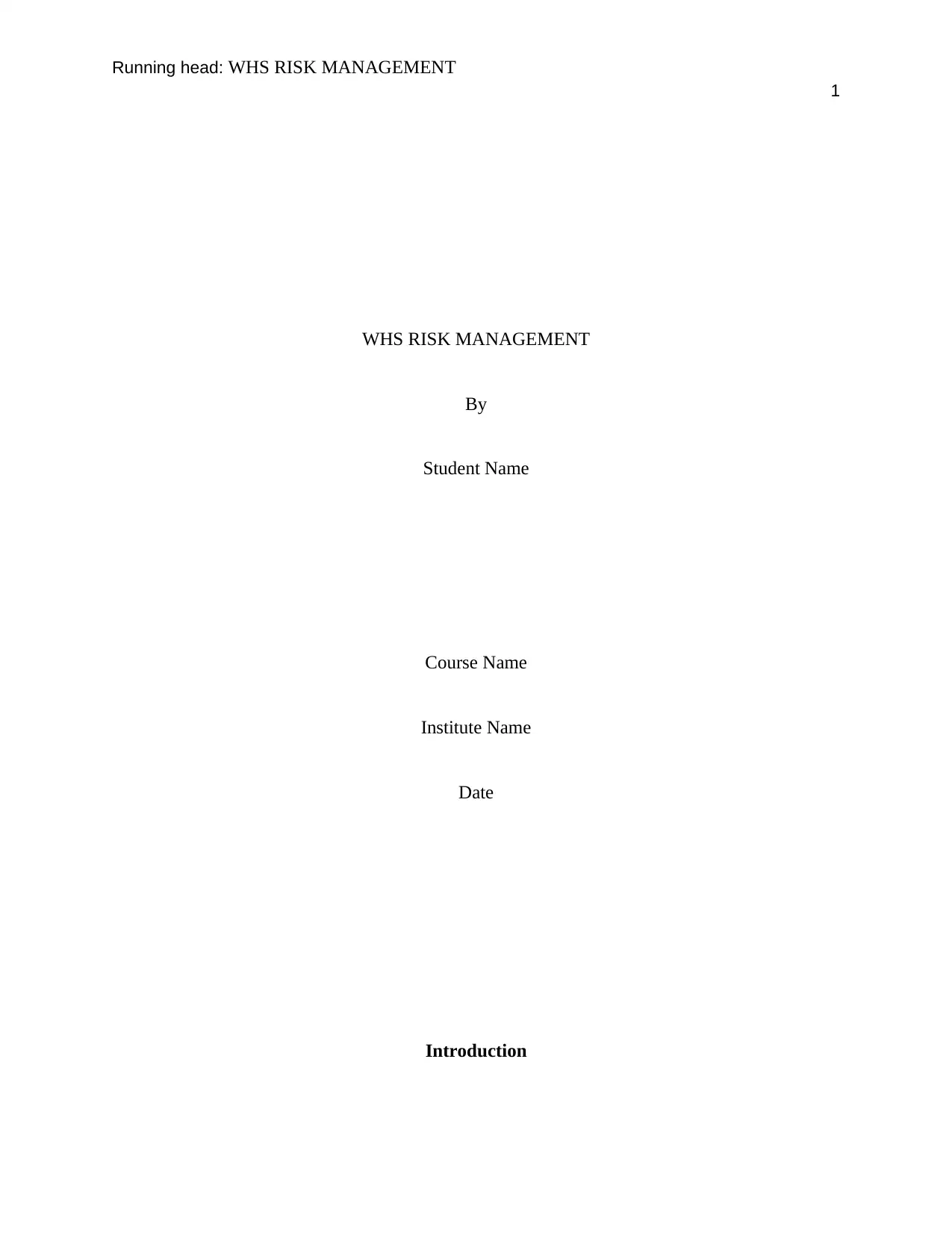
Running head: WHS RISK MANAGEMENT
1
WHS RISK MANAGEMENT
By
Student Name
Course Name
Institute Name
Date
Introduction
1
WHS RISK MANAGEMENT
By
Student Name
Course Name
Institute Name
Date
Introduction
Paraphrase This Document
Need a fresh take? Get an instant paraphrase of this document with our AI Paraphraser
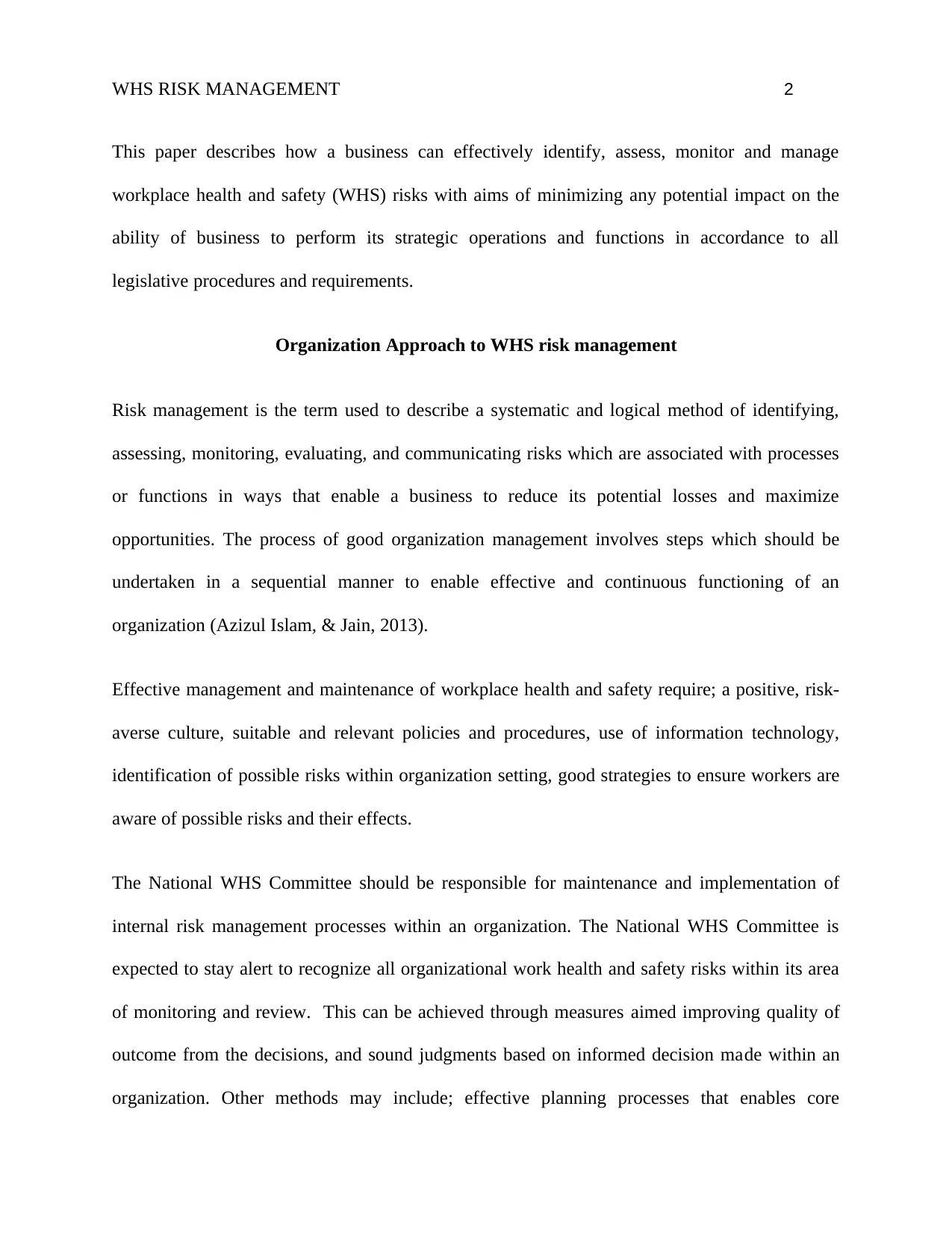
WHS RISK MANAGEMENT 2
This paper describes how a business can effectively identify, assess, monitor and manage
workplace health and safety (WHS) risks with aims of minimizing any potential impact on the
ability of business to perform its strategic operations and functions in accordance to all
legislative procedures and requirements.
Organization Approach to WHS risk management
Risk management is the term used to describe a systematic and logical method of identifying,
assessing, monitoring, evaluating, and communicating risks which are associated with processes
or functions in ways that enable a business to reduce its potential losses and maximize
opportunities. The process of good organization management involves steps which should be
undertaken in a sequential manner to enable effective and continuous functioning of an
organization (Azizul Islam, & Jain, 2013).
Effective management and maintenance of workplace health and safety require; a positive, risk-
averse culture, suitable and relevant policies and procedures, use of information technology,
identification of possible risks within organization setting, good strategies to ensure workers are
aware of possible risks and their effects.
The National WHS Committee should be responsible for maintenance and implementation of
internal risk management processes within an organization. The National WHS Committee is
expected to stay alert to recognize all organizational work health and safety risks within its area
of monitoring and review. This can be achieved through measures aimed improving quality of
outcome from the decisions, and sound judgments based on informed decision made within an
organization. Other methods may include; effective planning processes that enables core
This paper describes how a business can effectively identify, assess, monitor and manage
workplace health and safety (WHS) risks with aims of minimizing any potential impact on the
ability of business to perform its strategic operations and functions in accordance to all
legislative procedures and requirements.
Organization Approach to WHS risk management
Risk management is the term used to describe a systematic and logical method of identifying,
assessing, monitoring, evaluating, and communicating risks which are associated with processes
or functions in ways that enable a business to reduce its potential losses and maximize
opportunities. The process of good organization management involves steps which should be
undertaken in a sequential manner to enable effective and continuous functioning of an
organization (Azizul Islam, & Jain, 2013).
Effective management and maintenance of workplace health and safety require; a positive, risk-
averse culture, suitable and relevant policies and procedures, use of information technology,
identification of possible risks within organization setting, good strategies to ensure workers are
aware of possible risks and their effects.
The National WHS Committee should be responsible for maintenance and implementation of
internal risk management processes within an organization. The National WHS Committee is
expected to stay alert to recognize all organizational work health and safety risks within its area
of monitoring and review. This can be achieved through measures aimed improving quality of
outcome from the decisions, and sound judgments based on informed decision made within an
organization. Other methods may include; effective planning processes that enables core
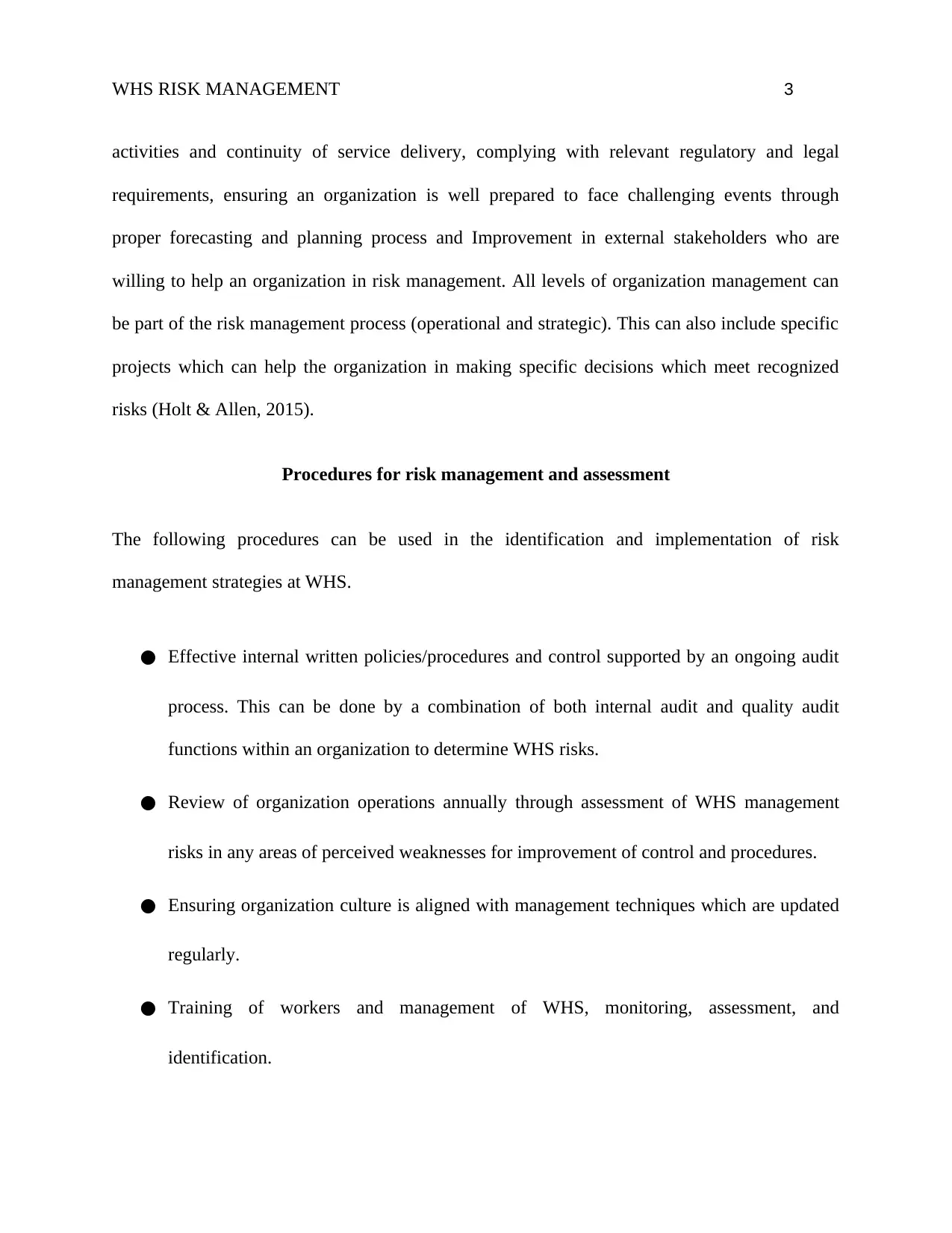
WHS RISK MANAGEMENT 3
activities and continuity of service delivery, complying with relevant regulatory and legal
requirements, ensuring an organization is well prepared to face challenging events through
proper forecasting and planning process and Improvement in external stakeholders who are
willing to help an organization in risk management. All levels of organization management can
be part of the risk management process (operational and strategic). This can also include specific
projects which can help the organization in making specific decisions which meet recognized
risks (Holt & Allen, 2015).
Procedures for risk management and assessment
The following procedures can be used in the identification and implementation of risk
management strategies at WHS.
● Effective internal written policies/procedures and control supported by an ongoing audit
process. This can be done by a combination of both internal audit and quality audit
functions within an organization to determine WHS risks.
● Review of organization operations annually through assessment of WHS management
risks in any areas of perceived weaknesses for improvement of control and procedures.
● Ensuring organization culture is aligned with management techniques which are updated
regularly.
● Training of workers and management of WHS, monitoring, assessment, and
identification.
activities and continuity of service delivery, complying with relevant regulatory and legal
requirements, ensuring an organization is well prepared to face challenging events through
proper forecasting and planning process and Improvement in external stakeholders who are
willing to help an organization in risk management. All levels of organization management can
be part of the risk management process (operational and strategic). This can also include specific
projects which can help the organization in making specific decisions which meet recognized
risks (Holt & Allen, 2015).
Procedures for risk management and assessment
The following procedures can be used in the identification and implementation of risk
management strategies at WHS.
● Effective internal written policies/procedures and control supported by an ongoing audit
process. This can be done by a combination of both internal audit and quality audit
functions within an organization to determine WHS risks.
● Review of organization operations annually through assessment of WHS management
risks in any areas of perceived weaknesses for improvement of control and procedures.
● Ensuring organization culture is aligned with management techniques which are updated
regularly.
● Training of workers and management of WHS, monitoring, assessment, and
identification.
⊘ This is a preview!⊘
Do you want full access?
Subscribe today to unlock all pages.

Trusted by 1+ million students worldwide
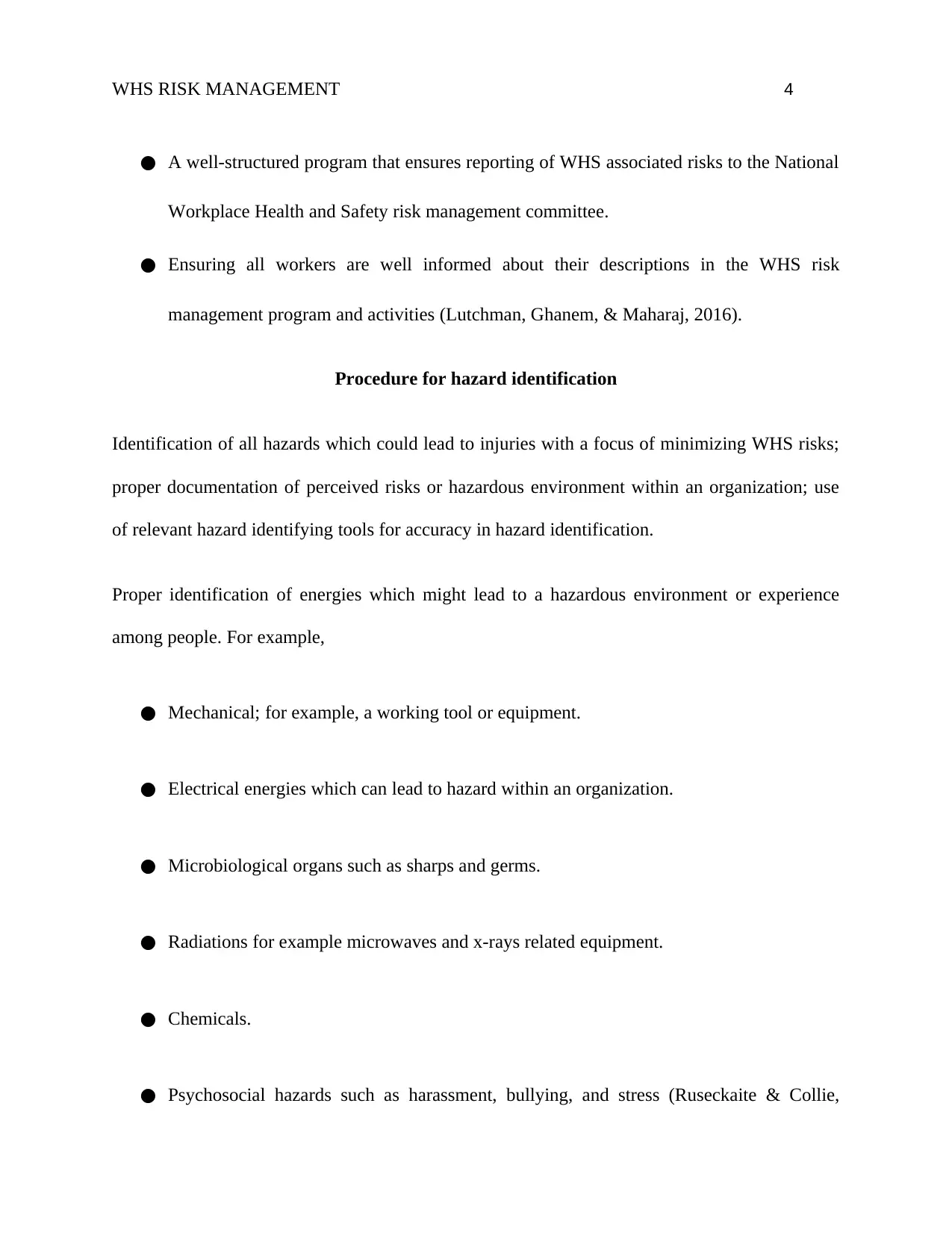
WHS RISK MANAGEMENT 4
● A well-structured program that ensures reporting of WHS associated risks to the National
Workplace Health and Safety risk management committee.
● Ensuring all workers are well informed about their descriptions in the WHS risk
management program and activities (Lutchman, Ghanem, & Maharaj, 2016).
Procedure for hazard identification
Identification of all hazards which could lead to injuries with a focus of minimizing WHS risks;
proper documentation of perceived risks or hazardous environment within an organization; use
of relevant hazard identifying tools for accuracy in hazard identification.
Proper identification of energies which might lead to a hazardous environment or experience
among people. For example,
● Mechanical; for example, a working tool or equipment.
● Electrical energies which can lead to hazard within an organization.
● Microbiological organs such as sharps and germs.
● Radiations for example microwaves and x-rays related equipment.
● Chemicals.
● Psychosocial hazards such as harassment, bullying, and stress (Ruseckaite & Collie,
● A well-structured program that ensures reporting of WHS associated risks to the National
Workplace Health and Safety risk management committee.
● Ensuring all workers are well informed about their descriptions in the WHS risk
management program and activities (Lutchman, Ghanem, & Maharaj, 2016).
Procedure for hazard identification
Identification of all hazards which could lead to injuries with a focus of minimizing WHS risks;
proper documentation of perceived risks or hazardous environment within an organization; use
of relevant hazard identifying tools for accuracy in hazard identification.
Proper identification of energies which might lead to a hazardous environment or experience
among people. For example,
● Mechanical; for example, a working tool or equipment.
● Electrical energies which can lead to hazard within an organization.
● Microbiological organs such as sharps and germs.
● Radiations for example microwaves and x-rays related equipment.
● Chemicals.
● Psychosocial hazards such as harassment, bullying, and stress (Ruseckaite & Collie,
Paraphrase This Document
Need a fresh take? Get an instant paraphrase of this document with our AI Paraphraser

WHS RISK MANAGEMENT 5
2013).
WHS Risk Control
Control of risks can be conducted based on the hierarchy of control. Below is a hierarchy of risk
control in decreasing order for effectiveness and desirability.
For effective WHS risk control, an organization needs to identify mandatory risks controls which
need an urgent risk assessment. Mandatory control measures should be put in place before a
process of control is conducted. The reasonable timeline must also be used to ensure proposed
mandatory risks are controlled to avoid the risk of WHS associated risks.
Risk Assessment Procedure
A documented process for WHS risk assessment should be established to help in the evaluation
of the effectiveness of the controls measures used by the organization in achieving a desirable
level of risk. The assessment process should be updated and reviewed regularly until a desirable
2013).
WHS Risk Control
Control of risks can be conducted based on the hierarchy of control. Below is a hierarchy of risk
control in decreasing order for effectiveness and desirability.
For effective WHS risk control, an organization needs to identify mandatory risks controls which
need an urgent risk assessment. Mandatory control measures should be put in place before a
process of control is conducted. The reasonable timeline must also be used to ensure proposed
mandatory risks are controlled to avoid the risk of WHS associated risks.
Risk Assessment Procedure
A documented process for WHS risk assessment should be established to help in the evaluation
of the effectiveness of the controls measures used by the organization in achieving a desirable
level of risk. The assessment process should be updated and reviewed regularly until a desirable

WHS RISK MANAGEMENT 6
level of risk is achieved within an organization. After achieving desirable levels, risk assessment
should be reviewed once:
● There is a significant change;
● At least every three years
● An incident or hazard Report is generated
Legislation codes of practice
● Code of Practice: Safety Data Sheets for Hazardous Chemicals Preparation.
● Code of Practice: Workplace Hazardous Chemicals Labeling.
Management of workplace WHS risks requires identification of chemical products by an
organization and educating their employee of perceived threats from these chemicals.
Organizations should conduct good research to identify possible threats or hazards to their
employees including chemical or equipment which may result in injuries to their employees.
Effective planning is required to address control measures on perceived hazard equipment within
an organization to ensure WHS is observed (Chan-Mok, Caponecchia & Winder, 2014).
PART B
Collection of information (student and his assessor) will be done by the student himself
Role play (student and assessor) done by the student himself
level of risk is achieved within an organization. After achieving desirable levels, risk assessment
should be reviewed once:
● There is a significant change;
● At least every three years
● An incident or hazard Report is generated
Legislation codes of practice
● Code of Practice: Safety Data Sheets for Hazardous Chemicals Preparation.
● Code of Practice: Workplace Hazardous Chemicals Labeling.
Management of workplace WHS risks requires identification of chemical products by an
organization and educating their employee of perceived threats from these chemicals.
Organizations should conduct good research to identify possible threats or hazards to their
employees including chemical or equipment which may result in injuries to their employees.
Effective planning is required to address control measures on perceived hazard equipment within
an organization to ensure WHS is observed (Chan-Mok, Caponecchia & Winder, 2014).
PART B
Collection of information (student and his assessor) will be done by the student himself
Role play (student and assessor) done by the student himself
⊘ This is a preview!⊘
Do you want full access?
Subscribe today to unlock all pages.

Trusted by 1+ million students worldwide
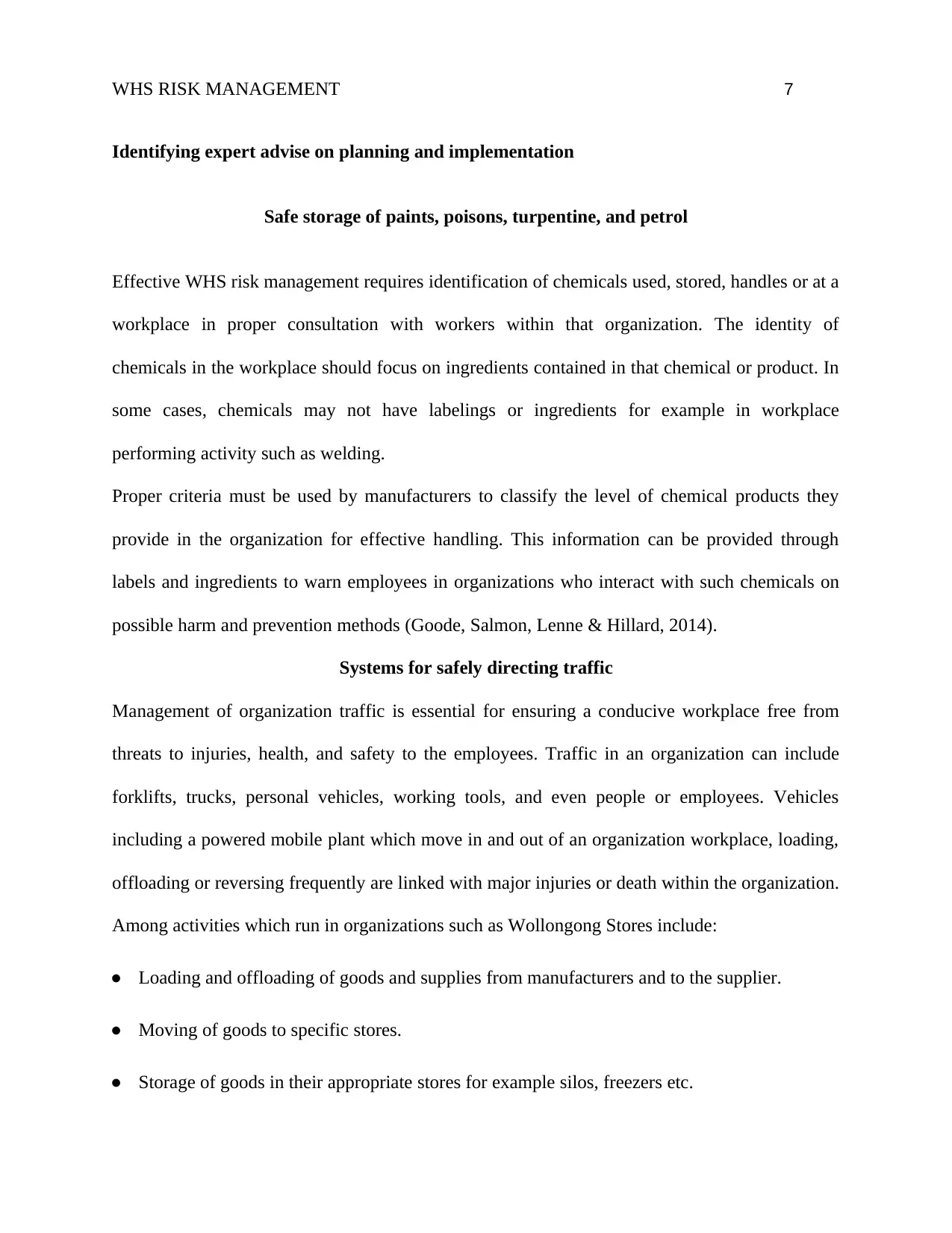
WHS RISK MANAGEMENT 7
Identifying expert advise on planning and implementation
Safe storage of paints, poisons, turpentine, and petrol
Effective WHS risk management requires identification of chemicals used, stored, handles or at a
workplace in proper consultation with workers within that organization. The identity of
chemicals in the workplace should focus on ingredients contained in that chemical or product. In
some cases, chemicals may not have labelings or ingredients for example in workplace
performing activity such as welding.
Proper criteria must be used by manufacturers to classify the level of chemical products they
provide in the organization for effective handling. This information can be provided through
labels and ingredients to warn employees in organizations who interact with such chemicals on
possible harm and prevention methods (Goode, Salmon, Lenne & Hillard, 2014).
Systems for safely directing traffic
Management of organization traffic is essential for ensuring a conducive workplace free from
threats to injuries, health, and safety to the employees. Traffic in an organization can include
forklifts, trucks, personal vehicles, working tools, and even people or employees. Vehicles
including a powered mobile plant which move in and out of an organization workplace, loading,
offloading or reversing frequently are linked with major injuries or death within the organization.
Among activities which run in organizations such as Wollongong Stores include:
● Loading and offloading of goods and supplies from manufacturers and to the supplier.
● Moving of goods to specific stores.
● Storage of goods in their appropriate stores for example silos, freezers etc.
Identifying expert advise on planning and implementation
Safe storage of paints, poisons, turpentine, and petrol
Effective WHS risk management requires identification of chemicals used, stored, handles or at a
workplace in proper consultation with workers within that organization. The identity of
chemicals in the workplace should focus on ingredients contained in that chemical or product. In
some cases, chemicals may not have labelings or ingredients for example in workplace
performing activity such as welding.
Proper criteria must be used by manufacturers to classify the level of chemical products they
provide in the organization for effective handling. This information can be provided through
labels and ingredients to warn employees in organizations who interact with such chemicals on
possible harm and prevention methods (Goode, Salmon, Lenne & Hillard, 2014).
Systems for safely directing traffic
Management of organization traffic is essential for ensuring a conducive workplace free from
threats to injuries, health, and safety to the employees. Traffic in an organization can include
forklifts, trucks, personal vehicles, working tools, and even people or employees. Vehicles
including a powered mobile plant which move in and out of an organization workplace, loading,
offloading or reversing frequently are linked with major injuries or death within the organization.
Among activities which run in organizations such as Wollongong Stores include:
● Loading and offloading of goods and supplies from manufacturers and to the supplier.
● Moving of goods to specific stores.
● Storage of goods in their appropriate stores for example silos, freezers etc.
Paraphrase This Document
Need a fresh take? Get an instant paraphrase of this document with our AI Paraphraser
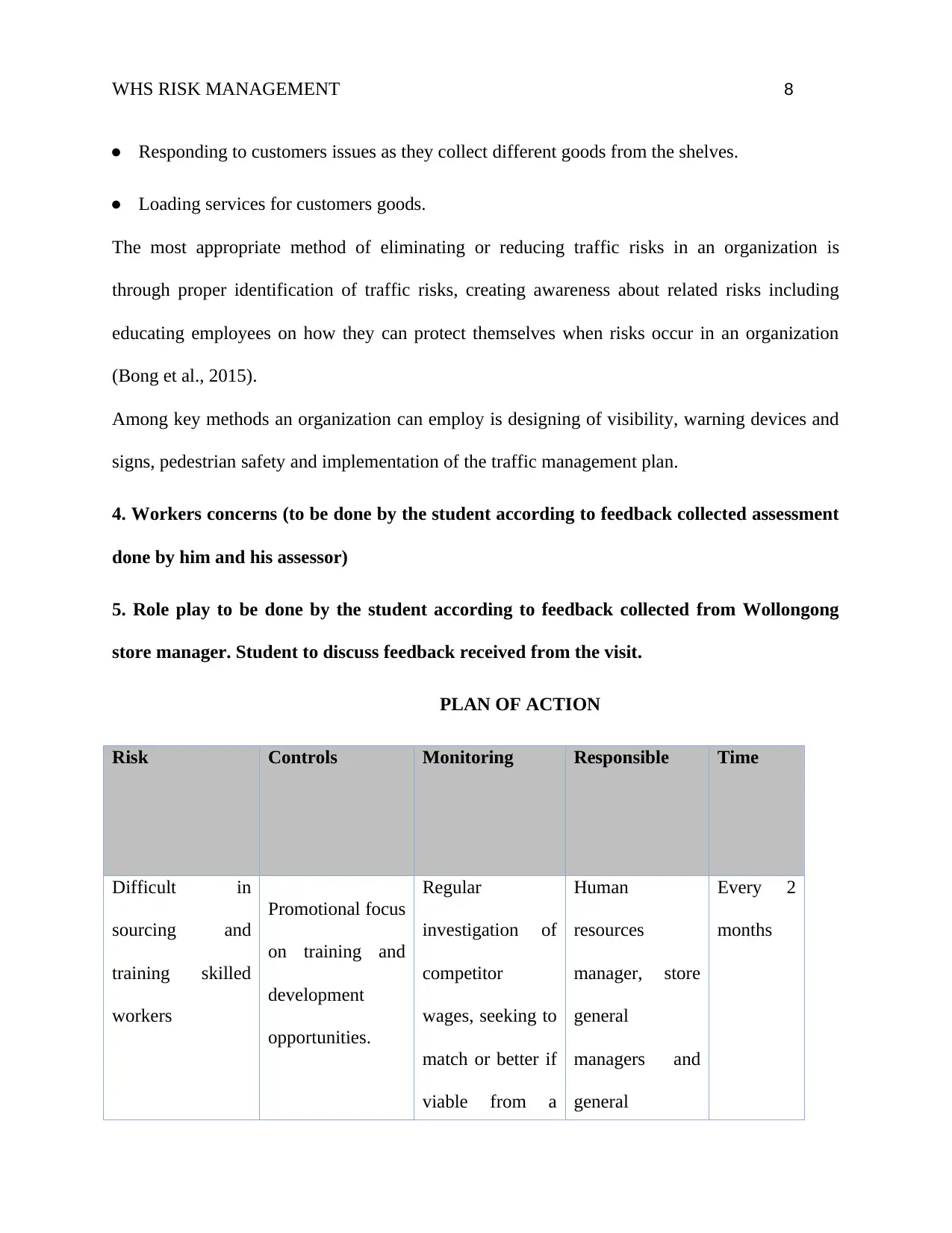
WHS RISK MANAGEMENT 8
● Responding to customers issues as they collect different goods from the shelves.
● Loading services for customers goods.
The most appropriate method of eliminating or reducing traffic risks in an organization is
through proper identification of traffic risks, creating awareness about related risks including
educating employees on how they can protect themselves when risks occur in an organization
(Bong et al., 2015).
Among key methods an organization can employ is designing of visibility, warning devices and
signs, pedestrian safety and implementation of the traffic management plan.
4. Workers concerns (to be done by the student according to feedback collected assessment
done by him and his assessor)
5. Role play to be done by the student according to feedback collected from Wollongong
store manager. Student to discuss feedback received from the visit.
PLAN OF ACTION
Risk Controls Monitoring Responsible Time
Difficult in
sourcing and
training skilled
workers
Promotional focus
on training and
development
opportunities.
Regular
investigation of
competitor
wages, seeking to
match or better if
viable from a
Human
resources
manager, store
general
managers and
general
Every 2
months
● Responding to customers issues as they collect different goods from the shelves.
● Loading services for customers goods.
The most appropriate method of eliminating or reducing traffic risks in an organization is
through proper identification of traffic risks, creating awareness about related risks including
educating employees on how they can protect themselves when risks occur in an organization
(Bong et al., 2015).
Among key methods an organization can employ is designing of visibility, warning devices and
signs, pedestrian safety and implementation of the traffic management plan.
4. Workers concerns (to be done by the student according to feedback collected assessment
done by him and his assessor)
5. Role play to be done by the student according to feedback collected from Wollongong
store manager. Student to discuss feedback received from the visit.
PLAN OF ACTION
Risk Controls Monitoring Responsible Time
Difficult in
sourcing and
training skilled
workers
Promotional focus
on training and
development
opportunities.
Regular
investigation of
competitor
wages, seeking to
match or better if
viable from a
Human
resources
manager, store
general
managers and
general
Every 2
months

WHS RISK MANAGEMENT 9
Regular training
for existing staff.
budgetary
perspective.
operations
managers.
Wastage or
unsaleable stock
from poor
inventory
maintenance and
sales monitoring.
Continuous
monitoring using
in-house ERM
system
Daily contact
with suppliers.
Daily automated
monitoring (with
alerts for issues)
and anticipation
of demand
through ongoing
research and
analysis in
consultation with
market research.
Store general
managers,
general
operations
managers, COO,
and marketing
general
manager.
Every 5
months
The emergence of
a competitor.
Continuous
implementation of
marketing
strategy to
highlight key
points of
difference
between us and
Continuous
monitoring of
competitors’
campaigns.
Marketing
general
manager.
Every 4
months
Regular training
for existing staff.
budgetary
perspective.
operations
managers.
Wastage or
unsaleable stock
from poor
inventory
maintenance and
sales monitoring.
Continuous
monitoring using
in-house ERM
system
Daily contact
with suppliers.
Daily automated
monitoring (with
alerts for issues)
and anticipation
of demand
through ongoing
research and
analysis in
consultation with
market research.
Store general
managers,
general
operations
managers, COO,
and marketing
general
manager.
Every 5
months
The emergence of
a competitor.
Continuous
implementation of
marketing
strategy to
highlight key
points of
difference
between us and
Continuous
monitoring of
competitors’
campaigns.
Marketing
general
manager.
Every 4
months
⊘ This is a preview!⊘
Do you want full access?
Subscribe today to unlock all pages.

Trusted by 1+ million students worldwide

WHS RISK MANAGEMENT 10
competitors.
Proper promotion
of hardware
equipments
Poor product
quality from
suppliers.
Continual audits
of product
quality.
Audit of supplier
quality.
Customer
complaints
monitoring.
Store general
managers and
general
operations
managers,
As much
as we can
Environmental
risk due to
operations of
Australian
Hardware.
Staff training (at
all levels) on
sustainable
practices at
Australian
Hardware.
Continual audits
of supplier
environmental
responsibility
with regard to
sustainability
principles.
Continual
auditing of
environmental
performance
Store general
managers,
general
operations
managers,
COO.
Every 4
months
competitors.
Proper promotion
of hardware
equipments
Poor product
quality from
suppliers.
Continual audits
of product
quality.
Audit of supplier
quality.
Customer
complaints
monitoring.
Store general
managers and
general
operations
managers,
As much
as we can
Environmental
risk due to
operations of
Australian
Hardware.
Staff training (at
all levels) on
sustainable
practices at
Australian
Hardware.
Continual audits
of supplier
environmental
responsibility
with regard to
sustainability
principles.
Continual
auditing of
environmental
performance
Store general
managers,
general
operations
managers,
COO.
Every 4
months
Paraphrase This Document
Need a fresh take? Get an instant paraphrase of this document with our AI Paraphraser

WHS RISK MANAGEMENT 11
against
sustainability
plan and external
benchmarking.
Changes to procedures
A planning process is a key to changes that an organization may need to update their strategies.
After a successful planning process organization will then adopt new policies which changes
how they provide their services to potential customers and how they treat their potential threats.
After the implementation adoption of new policies organization will then be ready to put their
new policies into action according to their desired outcomes.
Communication and Consultation
A safe workplace can be achieved when employees and employers converse to one another about
issues they are facing at work and finding solutions.
Consultation for information and ideas exchange between employees and employers is an
essential element for organization identification of potential hazards and how control measures
can be done (Xiang, Bi, Pisaniello & Hansen, 2014).
Ongoing, regular monitoring
Monitoring in the organization focuses on determining if there are other hazards which have
been created as a result of the implementation of new policies within the organization.
against
sustainability
plan and external
benchmarking.
Changes to procedures
A planning process is a key to changes that an organization may need to update their strategies.
After a successful planning process organization will then adopt new policies which changes
how they provide their services to potential customers and how they treat their potential threats.
After the implementation adoption of new policies organization will then be ready to put their
new policies into action according to their desired outcomes.
Communication and Consultation
A safe workplace can be achieved when employees and employers converse to one another about
issues they are facing at work and finding solutions.
Consultation for information and ideas exchange between employees and employers is an
essential element for organization identification of potential hazards and how control measures
can be done (Xiang, Bi, Pisaniello & Hansen, 2014).
Ongoing, regular monitoring
Monitoring in the organization focuses on determining if there are other hazards which have
been created as a result of the implementation of new policies within the organization.

WHS RISK MANAGEMENT 12
Ongoing monitoring in an organization is essential in the assessment of and efficiency and
effectiveness of recordkeeping systems to:
● ensure satisfactory within the organization and meeting the public office's needs.
● Identify achievements and successes.
● Complying with State Records.
● Continuous improvement in organization objectives.
● Upgrading organization tools and technology used in business.
Performance can be monitored by:
● Regular assessments on organizations records, objectives and strategies.
● Collecting and assessing feedback from potential clients.
● Benchmarking to find out how other organizations are conducting their businesses.
● Assessing policies used in the management of their records.
● Assessing organization progress through set indicators.
● Performing audits and analyzing audit reports to identify organization position in
business.
● Implementation of the use of an appropriate record keeping system that can guarantee the
accuracy and safety of organization data.
● Use of appropriate management strategies and approaches.
● Reviewing possible risks and threats to the business
Ongoing monitoring in an organization is essential in the assessment of and efficiency and
effectiveness of recordkeeping systems to:
● ensure satisfactory within the organization and meeting the public office's needs.
● Identify achievements and successes.
● Complying with State Records.
● Continuous improvement in organization objectives.
● Upgrading organization tools and technology used in business.
Performance can be monitored by:
● Regular assessments on organizations records, objectives and strategies.
● Collecting and assessing feedback from potential clients.
● Benchmarking to find out how other organizations are conducting their businesses.
● Assessing policies used in the management of their records.
● Assessing organization progress through set indicators.
● Performing audits and analyzing audit reports to identify organization position in
business.
● Implementation of the use of an appropriate record keeping system that can guarantee the
accuracy and safety of organization data.
● Use of appropriate management strategies and approaches.
● Reviewing possible risks and threats to the business
⊘ This is a preview!⊘
Do you want full access?
Subscribe today to unlock all pages.

Trusted by 1+ million students worldwide
1 out of 17
Related Documents
Your All-in-One AI-Powered Toolkit for Academic Success.
+13062052269
info@desklib.com
Available 24*7 on WhatsApp / Email
![[object Object]](/_next/static/media/star-bottom.7253800d.svg)
Unlock your academic potential
Copyright © 2020–2025 A2Z Services. All Rights Reserved. Developed and managed by ZUCOL.





